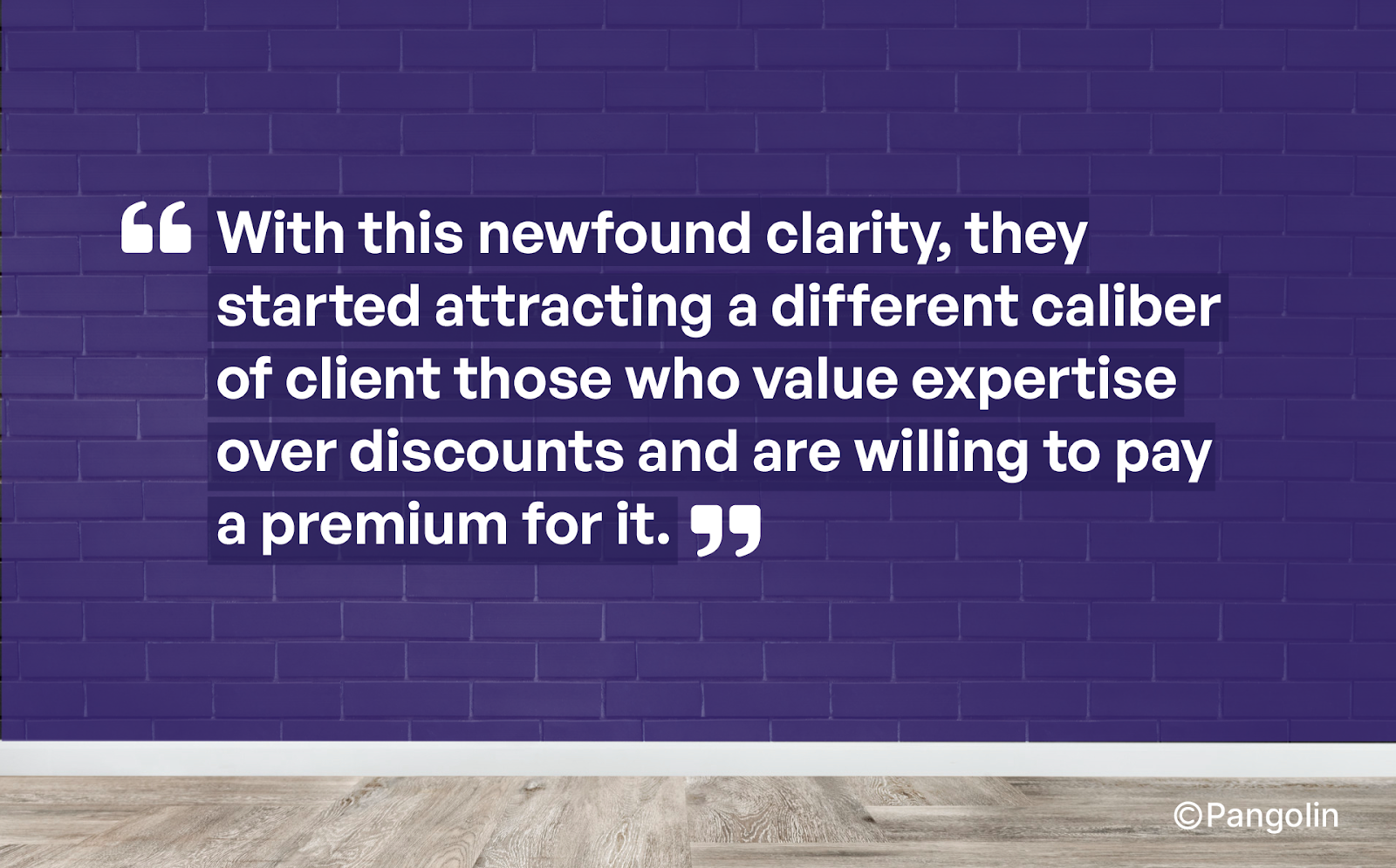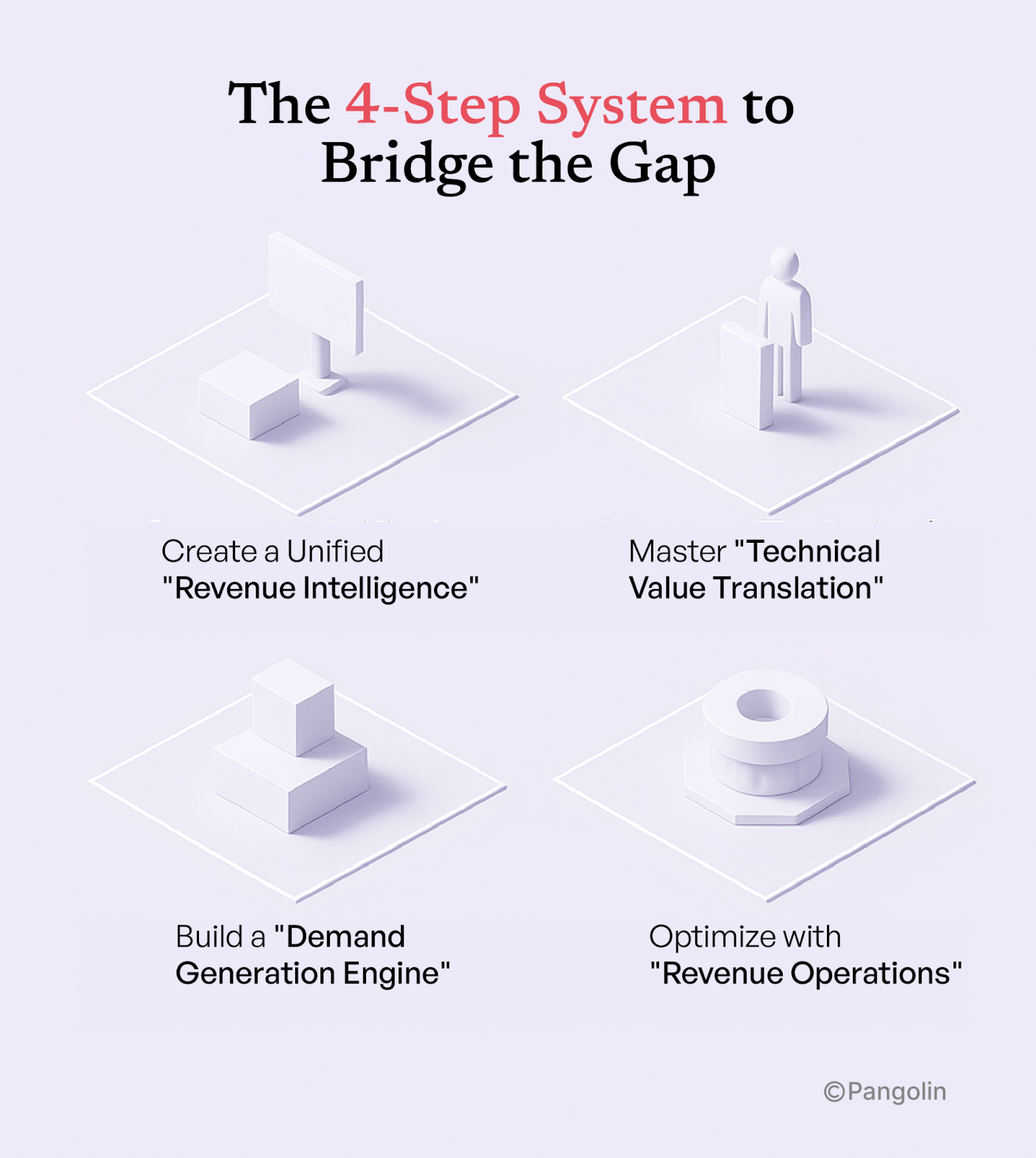

Earlier this year, archaeologists in Pompeii unearthed a massive, nearly life-sized fresco in a newly excavated banquet hall. Spanning three full walls of the room, the megalography depicts a secret initiation rite for the cult of Dionysus, the Greek god of wine, fertility, theater, and ecstasy.
Dating back to the 1st century BC, the fresco was already an antique by the time Mount Vesuvius erupted in 79 C.E.. Italy's Culture Minister, Alessandro Giuli, has rightly called the discovery historic.
You know what else is historic? Companies with tightly aligned sales and marketing see 208% more revenue from their marketing efforts. Yet most IT firms are leaking revenue thanks to a massive silent gap (read secret cult) between their sales and marketing teams.
Marketing celebrates leads that Sales calls garbage, while Sales chases deals Marketing knows nothing about. The result? Wasted budget, stalled growth, and a pipeline that's more guesswork than science.
But it's fixable. All you need is a 4-step system designed specifically for the complexities of an IT consulting business.
A system that turns friction into momentum and transforms your revenue engine from unpredictable to unstoppable. Let's break it down.
That secret gap between your sales and marketing teams is called misalignment. It's an invisible leak, and a headache, that can quietly siphon up to $2 million a year from an IT consulting firm's bottom line.
Here's a concrete, almost unbelievable number: 80% of leads generated by marketing are ignored by sales.
Think about that. For every 100 leads your marketing team works to bring in, 80 of them end up in a digital graveyard, untouched.
This isn't because your sales team is lazy. It's because sales and marketing alignment is broken, these teams are often playing two different games with two different rulebooks. Marketing's goal is to cast a wide net and bring in a high volume of leads. Sales, measured by closed deals, only has time to focus on the handful of leads they believe are ready to buy right now.
The result is a chaotic handoff where promising prospects get lost in the fog, and your marketing budget is effectively set on fire.
For an IT consulting firm, this problem is far worse than for a company selling simple products. Why? Because your entire business is built on navigating complexity.

Here's where the leak gets bigger:
This is a direct threat to your firm's growth and profitability. While you're trying to patch the leaks, your more aligned competitors are sailing right past you.
The gap between sales and marketing does more than just lose leads. It slowly poisons your entire firm from the inside out, creating a series of losses that are far more damaging.
First, your revenue velocity grinds to a halt. Deals that should take three months now take nine. Your pipeline, which should be a flowing river of cash, becomes a stagnant pond. Every stalled deal is another month of payroll you have to cover while waiting for the revenue to hit. That's a slow, painful bleed.
Next, your revenue forecast becomes a work of fiction. When sales and marketing data don't talk to each other, you can't trust your own numbers. You're flying blind, unable to make confident decisions about hiring, investment, or expansion. Every board meeting becomes a white-knuckle ride based on guesswork.
Then, the most painful loss of all: your top talent starts to walk. Your best engineers and consultants didn't join your firm to navigate internal politics; they came to solve complex problems. When they see chaos, messy handoffs, and a lack of clear direction, they start polishing their LinkedIn profiles. They quietly head for the exits, taking your innovation and institutional knowledge with them.
And the final blow? You get stuck competing on price, not value. Without a crisp, unified message, you sound just like everyone else. Your sales team is forced into a corner, offering discounts just to close deals. Your margins shrink, your brand weakens, and you become just another commodity vendor in a crowded market.
This is the slow, silent erosion of your firm's future.
So, what happens when you close that gap? What does the other side look like?
Imagine your sales and marketing teams operating like a well-oiled machine, smooth, synchronized, and unstoppable. The friction is gone. The finger-pointing stops. In its place is a powerful, unified engine for growth.
Companies that master sales and marketing alignment best practices report 32% higher annual revenue growth compared to misaligned competitors. This isn't luck. It's the compound effect of both teams pulling in the same direction.
For one of our IT consulting clients, this transformation meant their revenue grew 24% faster within a single year. How? They finally started telling one clear, compelling story. By positioning their technical capabilities with confidence, prospects immediately understood their unique value, completely bypassing the exhausting price wars.

This shift does more than just boost your bottom line. It turns your firm into a talent magnet. Your best engineers and consultants see the momentum. They feel the shared purpose. They not only stay, but they also become your biggest advocates, attracting other top performers to your door.
Strategic partnerships begin to flourish. When your value is crystal clear, other industry leaders see you not as just another vendor, but as a reliable, strategic collaborator.
This is more than just growth. It's a complete transformation from an underdog fighting for scraps to a market leader that owns its category.
Next, we'll break down the 4-step system that turns this vision into your reality.
Turning misalignment into a high-performance revenue engine isn't about a single piece of software or a new hire. It's about installing a simple, repeatable system. For IT consulting firms, that system has four core pillars that address how to align sales and marketing effectively.

Imagine trying to navigate a ship with two captains using two different maps. That's what happens when sales and marketing operate from separate data. The first step is to get everyone on the same map.
This is about creating a single source of truth for all revenue-related activity. It starts with technology but ends with people.
First, you integrate your core platforms, typically your CRM (like Salesforce or HubSpot) and your marketing automation tool (like Marketo or Pardot). When they talk to each other, both teams see the same leads, the same activities, and the same pipeline. There are no more data silos or debates about whose numbers are "right."
But technology is only half the battle. Next, both teams must sit down and agree on a shared dictionary:
Finally, establish a weekly alignment meeting. This isn't just another meeting for the calendar. It's a 30-minute, data-driven huddle where both teams review the pipeline, discuss lead quality, and share insights from the front lines.
IT Consulting-Specific Tip: Add a "technical capability" field to your CRM. Tagging leads and opportunities with specific technical needs (e.g., "AWS migration," "cybersecurity audit") allows you to route inquiries to the right experts instantly and demonstrates deep domain awareness from the very first touchpoint.
Your firm is full of brilliant technical minds. But your clients, especially the C-suite budget holders, don't buy technical brilliance. They buy business outcomes. Step two is about building a bridge between your technical expertise and the value your clients actually care about.
This is where marketing and sales alignment becomes critical. Both teams need to speak the same language when translating features into benefits. Instead of saying "We use a serverless architecture," say "We cut your infrastructure costs by 40% and eliminate downtime."
Create a business outcome messaging framework. For each of your core services, map the technical features to the corresponding business outcomes (e.g., increased efficiency, reduced risk, faster time-to-market). This becomes the bible for all your marketing and sales content.
From there, build sales enablement materials that help your sales team tell that value story. This includes:
IT Consulting-Specific Tip: Run "translation workshops" where your top engineers and your sales team work together. Have the engineers explain a complex technical concept, and then have the sales team practice re-explaining it in pure business terms. This builds mutual respect and a shared language.
Most IT firms are stuck in a reactive loop, waiting for RFPs to land in their inbox and then scrambling to respond. This is a recipe for low margins and unpredictable growth. The third step is to flip the script and build a proactive engine that generates your own demand.
Understanding the benefits of sales and marketing alignment here is crucial: when both teams collaborate on content strategy, you create a seamless buyer journey.
This starts with a content strategy that targets your technical buyers. Your future clients are hungry for expertise. Give it to them with in-depth content that actually solves their problems, such as:
Next, implement a lead scoring model that prioritizes prospects based on both their demographic fit and their behavior. If a lead from an ICP company downloads a technical whitepaper and then visits your pricing page, they should be fast-tracked to sales immediately.
For high-value enterprise clients, use an Account-Based Marketing (ABM) approach. Instead of casting a wide net, your sales and marketing teams work together to target a small list of dream clients with highly personalized, coordinated campaigns.
Finally, use automated nurturing sequences to stay in front of prospects during the long IT sales cycle. A well-timed email with a relevant case study can re-engage a cold lead and put you back on their radar.
IT Consulting-Specific Tip: Create a "gated" library of your most valuable technical content. To access it, prospects have to provide more detailed information about their technical environment. This not only gives you incredibly valuable qualification data but also positions your firm as a source of premium expertise.
Building a revenue engine is not a one-time project; it's a continuous process of optimization. This final step is about adopting a Revenue Operations (RevOps) mindset, where you are constantly measuring, analyzing, and improving your entire revenue process.
This is where B2B marketing and sales alignment becomes measurable and scalable. You need a dashboard with a few key metrics that you live and die by:
Use this data to run constant experiments. Test new messaging. Try new channels. Optimize your demo flow. The goal is to make small, incremental improvements that compound over time into massive gains in efficiency and revenue.

Theory is great, but results come from action. Here's a simple, 90-day roadmap to turn the 4-step system into a reality for your firm. Think of it as your journey from chaos to clarity.
The first month is all about getting your house in order.
Success in this phase means: Your teams are talking, your data is unified, and everyone agrees on the definition of a good lead.
Now that the foundation is set, it's time to start building.
Success in this phase means: Your sales team feels more confident, your marketing is more targeted, and you're starting to see a tangible improvement in lead quality.
With the engine running, the final month is about tuning it for performance.

A quick word of warning: The most common pitfalls are a lack of executive buy-in and inconsistent communication. This journey requires commitment from the top and a relentless focus on keeping both teams in sync. But with this roadmap, you've got a clear path to follow.
So how do you know this is all working? You trade guesswork for a simple, powerful scorecard. When your revenue engine is truly aligned, you'll see the proof in these five key metrics that track B2B sales and marketing alignment effectiveness:
Don't just track these numbers in a vacuum. Benchmark them against industry averages. For example, well-aligned B2B companies often see a 20-30% increase in conversion rates and close deals up to 15% faster than their misaligned peers.
This scorecard is your proof that the hard work of alignment is paying off, turning a leaky pipe into a high-pressure fire hose of revenue.
The numbers don't lie: companies that finally align their sales and marketing teams see a staggering 208% increase in revenue from their marketing efforts.
Right now, that revenue is slipping through your fingers. While you're dealing with the friction of misalignment, your competitors are syncing up, closing deals faster, and steadily moving upmarket. Every day you wait, the gap between you and them gets wider.
At Pangolin, we specialize in guiding IT consulting firms through this exact transformation. We don't offer vague theories; we provide proven frameworks and the hands-on expertise to turn your revenue engine into a well-oiled machine.
The question is whether you can afford not to invest in alignment?
Ready to stop the leak and start building a predictable growth engine? Contact us to start your transformation.
This piece was authored by Kavya Somani and Aniket Panja, content strategists specializing in B2B marketing frameworks. Design and visual identity were led by Adhiraj Jadhav and Sohini Some. Adil Abdul and Yugandhar LakshmiNarayana shaped the user experience, while Yuva Priyadarshini and Aniket Singh optimized for search and discoverability. Deepti Karn served as project manager.
Special thanks to Avani Nagwann and Shashank Ayyar for their guidance throughout development.
